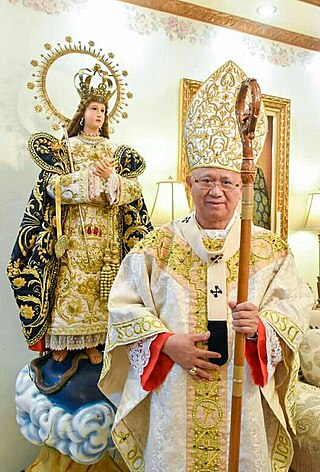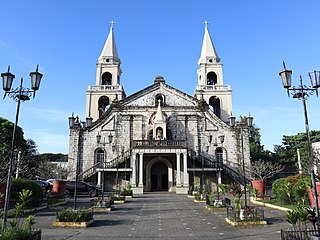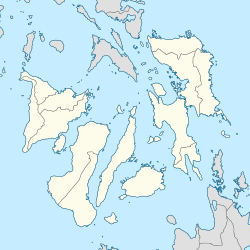
Iloilo, also called Iloilo Province, officially the Province of Iloilo, is a province in the Philippines located in the Western Visayas region. Its capital and largest city is Iloilo City, the regional center of Western Visayas and politically independent from the province. Iloilo occupies the southeast portion of the Visayan island of Panay and is bordered by the province of Antique to the west, Capiz to the north, the Jintotolo Channel to the northeast, the Guimaras Strait to the east, and the Iloilo Strait and Panay Gulf to the southwest.

Dumangas, officially the Municipality of Dumangas, is a 1st class municipality in the province of Iloilo, Philippines. According to the 2020 census, it has a population of 73,899 people.

Barotac Nuevo, officially the Municipality of Barotac Nuevo, is a 2nd class municipality in the province of Iloilo, Philippines. According to the 2020 census, it has a population of 58,176 people.

Banate, officially the Municipality of Banate, is a 4th class municipality in the province of Iloilo, Philippines. According to the 2020 census, it has a population of 33,376 people.

José Serofia Palma O.P. is a Filipino prelate and a professed member of the Dominican Order who is currently serving as the Archbishop of Cebu since 15 October 2010. He had previously served as Archbishop of Palo in Leyte. He also served as president of the Catholic Bishops' Conference of the Philippines from 2011 to 2013.

The National Shrine of the Our Lady of Candles, also known as the Metropolitan Cathedral of Saint Elizabeth of Hungary and colloquially as Jaro Cathedral, is a cathedral located in the district of Jaro in Iloilo City, on the island of Panay in the Philippines. The seat of the Roman Catholic Archdiocese of Jaro, it was placed under the patronage of Saint Elizabeth of Hungary. It was established in 1575 as a visita (chapel-of-ease) of Oton by the Augustinians and as a separate parish in 1587. The present-day structure of Jaro Cathedral was built in 1874.
St. Anthony of Padua Church may refer to:

Ancestral houses of the Philippines or Heritage Houses are homes owned and preserved by the same family for several generations as part of the Filipino family culture. It corresponds to long tradition by Filipino people of giving reverence for ancestors and elders. Houses could be a simple house to a mansion. The most common ones are the "Bahay na Bato". Some houses of prominent families had become points of interest or museums in their community because of its cultural, architectural or historical significance. These houses that are deemed of significant importance to the Filipino culture are declared Heritage House by the National Historical Commission of the Philippines (NHCP), previously known as the National Historical Institute (NHI) of the Philippines. Preservation is of utmost importance as some ancestral houses have come into danger due to business people who buy old houses in the provinces, dismantle them then sell the parts as ancestral building materials for homeowners wishing to have the ancestral ambiance on their houses. These ancestral houses provide the current generation a look back of the country's colonial past through these old houses.

The Iloilo State University of Fisheries Science and Technology (ISUFST) is a government research university located at Tiwi, Barotac Nuevo, Iloilo, Philippines.

Santo Tomás de Villanueva Parish Church, commonly known as Miagao Church, is a Roman Catholic church located in Miagao, Iloilo, Philippines. It is under the jurisdiction of the Archdiocese of Jaro. The church was declared as a UNESCO World Heritage Site on December 11, 1993, together with San Agustin Church in Manila; Nuestra Señora de la Asuncion Church in Santa Maria, Ilocos Sur; and San Agustin Church in Paoay, Ilocos Norte under the collective title Baroque Churches of the Philippines, a collection of four Baroque Spanish-era churches.

Santa Barbara Parish Church is a Roman Catholic church located in the municipality of Santa Barbara, Iloilo, Philippines, under the Archdiocese of Jaro. The church is considered to be the "Cradle of Independence" in Panay and in the Visayas.

San Joaquin Parish Church, commonly known as San Joaquin Church, is a Roman Catholic Church in the municipality of San Joaquin, Iloilo, Philippines within the jurisdiction of the Archdiocese of Jaro. It is largely known for its pediment featuring a military scene, the Spanish victory over the Moors in the Battle of Tétouan. The church was declared a National Cultural Treasure by the National Museum of the Philippines.

The San Joaquin Campo Santo is a Roman Catholic cemetery situated in the town of San Joaquin in Iloilo, Philippines. It is a designated as a National Cultural Treasure by the National Museum of the Philippines together with San Joaquin Church.

Nuestra Señora de la Purificación y la Candelaria is a venerated image of the Blessed Virgin Mary enshrined in Jaro Cathedral and the patroness of Western Visayas.
Philippines National Historic Landmarks is a registry of historic sites in the Philippines that have been officially declared by the Philippine Registry of Cultural Property.

Santa Ana Parish Church, commonly known as Molo Church, is a neogothic Roman Catholic church located in the district of Molo in Iloilo City, Iloilo, in the Philippines. It is under the jurisdiction of the Archdiocese of Jaro. The church is recognized as "the women's church" or "the feminist church" because it only features images of female saints inside, including Saint Anne, the patron saint of Molo. The National Historical Institute declared it a national landmark in 1992.

San Jose Placer Parish Church, also known as San José de Placer Church, is a Roman Catholic church in Iloilo City, Philippines. It is under the jurisdiction of the Archdiocese of Jaro. It was built in 1607 by the Jesuits and is considered the first ever church in the city of Iloilo. The church houses the replica of Santo Niño de Cebú, the patron saint of the Dinagyang Festival. It is located in what was once known as Plaza Alfonso XII, now Plaza Libertad, a historic plaza in Iloilo City.

Jaro Belfry, also known as Campanario de Jaro, is a historic free-standing bell tower located in front of the Jaro Metropolitan Cathedral in Jaro, Iloilo City, Philippines. It is one of the few belfries in the country that stands apart from the church where it belongs.

Saint Augustine Parish Church, commonly known as Dumangas Church, is a Roman Catholic church located in Dumangas, Iloilo, Philippines. It is under the jurisdiction of the Archdiocese of Jaro. The church is considered as the first and oldest Roman Catholic church in Western Visayas. The National Historical Commission of the Philippines (NHCP) declared it a national landmark in 1983.






















